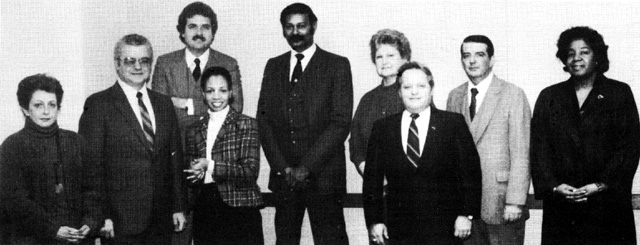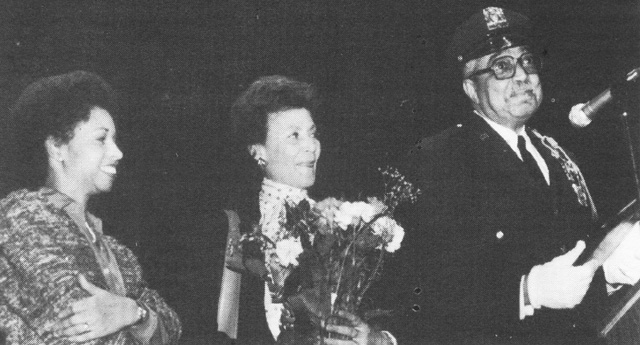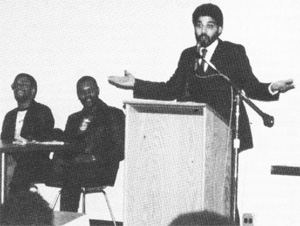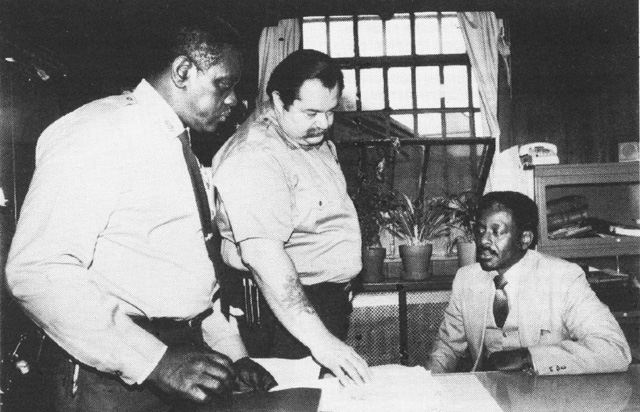

 |
|
In the June 1985 "Inside/Out"issue, the image above and the headline and text immediately below appeared on the front page. |
 |
|
The City and its Department of Correction will be on display this August for corrections personnel the nation over who attend the American Correctional Association's 115th Congress of Correction -- the first Congress staged in New York City in a quarter-century. While some D.O.C. personnel are A.C.A. members who will attend sessions of the Congress, a greater number of departmental employees will help with security at the Congress and play host to delegates who tour facilities at the Tombs and on Rikers Island. The official host agency for the Congress, the State Correctional and Youth Services Association, has delegated responsibility for security to the City D.O.C. Commissioner Jacqueline McMickens, Co- Chair of the Host Committee, and Chief of Operations Gloria Lee, C.A.Y.S.A. Vice President, have assigned Supervising Warden Martin Monteiro to coordinate security arrangements. The major body of the Congress runs from Sunday, August 11 through Thursday August 15, and one of the highlights for about 5,000 delegates and guests should be "New York Night" -- a gala evening of entertainment and food aboard the Staten Island Ferry on Monday night, August 12. A special subway train will shuttle guests between the midtown Congress headquarters at the Hilton and the Sheraton Hotels and the Whitehall Street Ferry Dock. Once aboard the ferry, guests will have a choice of music and cuisine on three separate decks with a panoramic view of the City as a backdrop -- all for just $30 per person. Employees of the Department of Correction may participate in this event even if they are not A.C.A. members or Congress delegates. If you would enjoy spending a summer's night in New York Harbor, hobnobbing with leaders in the correctional field the nation over, the Department's Director of Special Events, Sandra Lewis Smith, can supply more information at 374-XXXX. Those facilities playing host to delegate tours will be the Manhattan House of Detention, which has quickly gained a wide reputation as one of America's outstanding urban jails; the Anna M. Kross Center, one of the nations largest detention facilities; and the Rikers Island Complex. The theme of the Congress will be, "Public Policy/Public Perceptions: Challenges for Corrections." It will be explored from a variety of perspectives in 14 major tracks and 62 supporting sessions, a series of intensive skills training workshops, and opening general and plenary sessions of the Congress. There will also be an extensive display of the latest technological advancements in correction, exhibited by corporations from across the country. "We are most pleased that the A.C.A. has chosen New York City for its 1985 Congress and that we have been |
 EXPERTS: Stellar panel who participated in C.A.Y.S.A. session on Rikers Island included [above] John Jay College President Gerald Lynch, the moderator; Edna McConnell Clark Foundation President John Coleman, Assistant Nassau County District Attorney Harvey Levinson, Assembly Codes Committee Senior Counsel James Yates, and [below] Correction Commissioner Jacqueline McMickens, State Supreme Court Appellate Justice William Thompson, former Deputy Mayor Nicholas Scopetta, and Onondaga County Correction Commissioner William Ciuros, who heads C.A.Y.S.A. In the June 1985 issue of "Inside/Out," the images above and below formed a single wide photo accompanying a story on Page 8 about a DOC-John Jay College forum, at then CIFM, entitled "Correction: Its true role in the System." Ciuros was DOC Commissioner Ciuros 1/9/78 -- 8/12/79.
able to play such an important role with the Host Committee," Chief Lee said, "While not every one of our employees will be able to attend the sessions, our agency will be on display that week and I hope many of you share my excitement at that prospect. I also hope that a good number of our people can participate in New York Night. It will be our chance to show our visitors that we in the Big Apple not only work hard at providing proper correctional services, we also know how to throw one fine party." |
 |
|
In the June 1985 "Inside/Out"issue, the image and caption above and the headline and text immediately below were on Page 3. |
|
|
|
Every couple of months when the Training Academy staff trekked over to Brooklyn College for graduation ceremonies, Officer Jimmy Carter was the man they left behind. It was not a snub, but rather a point of honor for the genial, bespectacled veteran who is in his 30th year at Correction and has spent the past 20 of them at the Academy. Carter knew he could be trusted to held down the fort, so to speak, and catch up on the paperwork that has become his specialty in recent years. So when Capt. Fran Patterson told Jimmy he'd be needed at Brooklyn College for the graduation and promotion ceremony the week before Christmas, he wondered. went home and told my wife, "Maybe I've worn out my welcome." Fat chance. Actually, Rose Carter had to stifle a smile because she knew that it was all a ruse. Carter had been asked to come to the ceremony to present an award to Commissioner Jacqueline McMickens, but actually it was she who was doing the presenting -- a plaque proclaiming Carter as "Officer of the Decade" and a bouquet for Mrs. Carter, who had been driven down from the Bronx to be a part of her husband's special day of recognition. Flanked by Academy commander James Garvey and her fellow former commanders, Wardens Vernon Bain and Thomas Murray, the Commissioner read the inscription and then recalled in her remarks what it used to be like at the old "Academy" -- two rooms in what is now Rikers Island Security headquarters. "We had to wait to get in," she said, "and there were two pot-belly stoves for heat. "Those are the conditions under which Jimmy Carter taught us about this job." Later, after accepting his award and posing for pictures, Officer Carter recalled one of his first students, just 20 years ago. "Oh, yes," he said. "I remember the Commissioner very well. No matter what you said, she always had a question: 'Why?' "No matter how you put it, she always wanted you to break it down for her a little better. "You could tell even then how sharp she was." |
 ROOKIES SPEAK OUT: In an effort to learn more about the training process while it was providing more training, the Department recently inaugurated a probationary officers' seminar program, bringing nearly 300 officers to John Jay College for a full day of workshops and discussions designed to determine what their first six months as officers has been like and how relevant the Academy training they received was. Here [above], in an afternoon panel session, CO. Robert Lopez of C.I.F.M. responds to a question. Others on speak-out panel were, seated from left [above], Officers Kenneth Manigault, A.M.K.C. and Kevin Mills, Brooklyn HDM. {Below] Warden Otis Bantum, the moderator, listened. Others on speak-out panel were, seated from right, Terrence Felix, North Facility; Jeanine Sullivan, H.D.M. and Dominick Principato, A.R.D.C.. In the June 1985 issue of "Inside/Out," the images above and below formed a single wide photo on Page 11. The image has been divided here to fit the web page format. The caption has been somewhat modified to reflect the change.
|

How important is fluoroscoping of packages? It might have saved some inmate a nasty slash earlier this year when officers spotted a blade inside a fully-wrapped and sealed bar of Coast brand soap. Even after the wrapper had been removed the striations on the bar made the cut very hard to spot before Assistant Chief of Operations Peter Mahon performed surgery (right) and exposed the razor blade imbedded cleverly in the soap -- but not quite cleverly enough. In the June 1985 issue of "Inside/Out," the images above and below and their common caption appeared on Page 11.
|
Think you know a lot about the City
inmate population?
The Department's Information Systems Unit set out to analyze a cross-section of the population by describing everything it could about inmates in custody on a single day. The information developed for the day chosen, June 30, 1984, supports some long held premises and challenges others. While such a one-day statistical analysis -- "a snapshot" in data retrieval terminology -- is prone to some distortion, the results of the June 30th study can certainly provide food for thought and a basis for further studies. Here are some of the tidbits gleaned from the computerized snapshot of 10,361 inmates who were in City Correction custody for all or part of the final day of the last fiscal year, June 30,1984:
As the Department of Correction continues to add to its computer capabilities in the months and years ahead, more sophisticated data will enable the agency to better manage our own population and participate more meaningfully on the overall dialogue on crime within the criminal justice system and community at large. In the "Inside/Out" June 1985 issue, the headline and text above appeared on Page 3. |
Click on an individual manager photo below to see larger version. Use your browser's BACK button to return. |
|
Click on an individual manager photo above to see larger version. Use your browser's BACK button to return. |
|
|
 |
|
In June 1985 "Inside/Out"issue, the image, caption and headline above and text immediately below were on the last page (12). |
 Deputy Warden Marvin Fischer . . . during a speaking engagement . . . . During an intensive seven week course participants wrote and delivered their speeches on the Department. Each speaker was videotaped and then critiqued by the instructor, Joan Alevras of the Resource Center of Nutley, New Jersey, and the other participants. Breathing techniques, avoidance of excessive hand movements, methods to fend off nervousness, and other hints about public speaking were given to the 30 participants. . . . Deputy Warden Marvin Fisher of the Brooklyn House of Detention spoke before 30 members of the Brooklyn Rotary Club at Gage and Toilner, a Brooklyn restaurant. . . . In the June 1985 issue of "Inside/Out," the photo from which the above image was extracted and, the caption from which the above image nameline was excerpted, headline and the story from which the above text was excerpted appeared on Page 5.

OPEN HOUSE: The Department's new baby nursery on Rikers Island was dedicated with a ribbon cutting (left) with Jerline Jones of the
Montefiore Medical Center, Deputy Commissioner Frank Headley, Assistant Commissioner Evelyn Bridges, Commissioner George Gross of
the City Human Resources Administration, Nursery Director Deirdre Budd of Montefiore and Commissioner Jacqueline McMickens
participating in the ceremony.
In the June 1985 issue of "Inside/Out," the image and and caption excerpt above appeared on Page 10. The nursery opened in the Correctional Instution for Women which later became the George Motchan Center after the Rose M. Singer Center opened in 1988.

In the June 1985 issue of "Inside/Out," the newsletter masthead appeared on Page 9 listing officials and staff and the publication's address, Room 1509 at 100 Centre St. |
It is called Rikers Island Hospital, but
really it is not a hospital at all, but an
infirmary. Just east of the House of Detention for Men, it is one of the oldest structures on Rikers Island, but it is serving two of the department's newest needs. Rikers Island Hospital (it had to be a hospital back before 1966 when there was no overland link to the rest of the city for medical emergencies) houses the department's central protective custody unit as well as the unit that tends to all male AIDS victims in City custody. The Administrative Segregation Security Area is located on the second floor of the Rikers Island Infirmary and has seen the likes of Mark David Chapman. the two nun rapists, and others who receive media notoriety because of the accused crimes. Among those housed most recently have been David Crosby, leader of the 60's folk rock group Crosby, Stills, Nash, and Young; subway gunman Bernhard Goetz and accused Palm Sunday Massacre murderer Christopher Thomas. Despite their alleged crimes, the men housed in this area are usually subdued. According to Walter Simmons, Deputy Warden in charge of the facility who has been assigned there since December 1984, "We have no management problems in that security area; there are no disturbances. The most activity we've had in this area were media inquiries and calls about Bernhard Goetz." Physically, the area houses 13 inmates, one man per cell. These inmates receive all the minimum standards and consent decrees afforded other inmates. These men have access to a common dayroom "patio" area enclosure immediately outside their cell. At all times there are two officers on the floor. One officer, Robert James, has worked in this area for six years and with the Department for nearly 30 years. "Working here hasn't been a problem. It is a high security area," said Officer James. "You have to be alert. The inmates have to conform to the rules and regs of the Department and to the officer on the floor. "That officer gives them their recreation, food, telephone calls. Occasionally there's an outburst, but I am the type of person who likes control. I don't tolerate anything else. But generally I get along with most of the inmates on the floor." Possibly one of the better known inmates is Christopher Thomas, the Palm Sunday defendant. He is described as a very talkative, courteous, religious type who watches a locally televised sermon every Sunday. Officer James said, "When they first come in, many of the inmates may have a feeling of guilt for their accused crimes but after a day or two they come around." Officer James maintains a certain amount of aloofness on the job which adds to his professionalism. "I don't get involved with the inmates personally," he says. "If there is something I can do for them, I do it. Some people may say that sounds like a social worker but I am here to insure they get what is due them by law. If they have a complaint I handle it, if I can't I tell the captain. On the whole the area is calm. I find the best way to maintain control is not to create any tension." Within the infirmary there's another unit in charge of the daily care of the Department's AIDS (Acquired Immune Deficiency Syndrome) inmates in a 13-cell area. According to the head of the facility, this, too, is not a problem area and it is not a different operation from the rest of the infirmary. At certain times the correction officers use their initiative to solve problems for inmates in this area, Deputy Warden Simmons said. "One inmate had self-inflicted wounds" he said. "To prevent the inmate from cutting or scratching the people around him and contaminating them with his blood, the two officers restrained the inmate who was irrational at the time. The officers got a letter of appreciation for stopping a hazardous situation." Correction officer Dennis Raftery, a 13-year veteran with the Department and father of 12 children, has worked the AIDS areas for the past several years. CO Raftery said, "I don't have any fears about working here. Medical input from Montefiore Medical Center about how you can get AIDS through sexual contact stopped my fears. "I see Dr. Stewart of Prison Health Services taking blood and he is very relaxed. He's comfortable handling AIDS patients. That makes me feel comfortable, too." Officer Raftery added that the Department made information about AIDS available to the officers through papers on AIDS, medical journals, In his duties CO Raftery adheres to departmental guidelines in dealing with AIDS patients. He said, "I try to exchange information with them about their disease. Very often judges, social workers, and legal aid lawyers do not want to see an AIDS inmate. Once the AIDS becomes activated most of these men will die within 18 months, although many of them believe they are not going to die. Yet, they are not that angry." In the "Inside/Out" June 1985 issue, the headline and text above appeared on Page 3. |
|| To Sidelights List || To The Pen List || To Inside Out List || To Correction News List || |